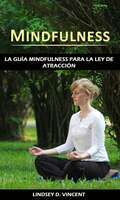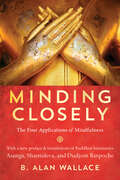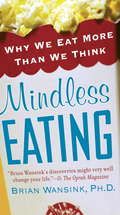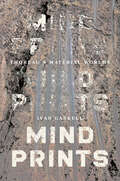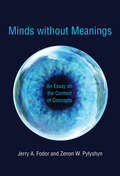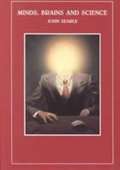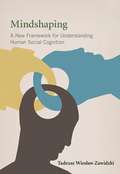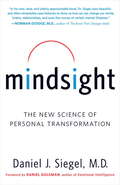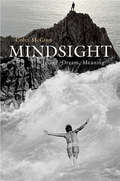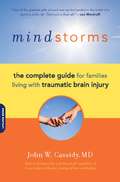- Table View
- List View
Mindfulness: Una guía práctica de mindfulness para principiantes
by Hope J. ScipioNo habrá dos formas de hacerlo. Cuando termine el libro, sabrá que es un hecho. Una vez que la meditación de atención plena se convierte en parte de su vida, las cosas cambian drásticamente y ya no responde a la vida con la misma ansiedad. La atención plena le sigue en todo lo que hace, y cuando la practica a diario, se convierte en parte de quién es. Usted encontrará: Meditaciones guiadas y afirmaciones subliminales para inducir un estado consciente y relajado. Ejercicios de respiración y técnicas de exploración corporal para despejar la mente. Sesiones de hipnosis para conciliar el sueño rápido Este libro no estaría completo sin enumerar varios ejercicios de meditación de atención plena que son apropiados para niños en edad escolar y ejercicios de atención plena para adolescentes también. Todos estos ejercicios son fáciles de seguir, usar y aplicar.
Mindfulness: Una guía sencilla para aliviar el estrés rápidamente
by Lewis Z. WrightCada uno de nosotros es capaz de ser consciente. Es una habilidad natural que poseemos y una de las herramientas que más se pasan por alto que tenemos disponibles para ayudarnos a enfrentar los factores estresantes diarios que encontramos en nuestra rutina diaria. En esta guía fácil de seguir aprenderá: •.De donde proviene la atención plena •.Cómo funciona la atención plena •.Cómo empezar a vivir conscientemente •.Las mejores formas de superar la ansiedad •.Trucos para lidiar con la depresión •.Entender cómo calmar su ira. •.Qué hacer cuando tiene problemas para comenzar con la atención plena •.Cómo utilizar la atención plena para dormir bien por la noche •.Cómo la atención plena puede ayudar a controlar el dolor Y mucho más La atención plena no eliminará el estrés de su vida por completo, pero puede ayudarlo a manejarlo a través de los pequeños cambios que realice. Provoca los cambios necesarios en su vida enseñándole a modificar la forma en que mira las cosas. Sí, los problemas van y vienen. Siempre lo harán y, a veces, eso está fuera de su control.
Mindfulness: Usando la nueva ciencia de la salud y la felicidad
by Lindsey D. VincentCuando se trata de libros fáciles de seguir sobre meditación y atención plena para principiantes, estas en el lugar correcto; esa es exactamente la razón por la que esta guía de meditación incluye un capítulo especial sobre la incorporación de la meditación de conciencia plena en tu agitada vida diaria. A través de este libro aprenderás: -Cómo el Mindfulness puede ayudarte a reducir el estrés -La naturaleza de tu verdadera mente -Cómo hackear tu mente -Los desafíos y beneficios de ser consciente -Entrenamiento formal e informal en Mindfulness ¡Y mucho más! Esta guía te mostrará cómo integrar la meditación Mindfulness en las actividades cotidianas para que se convierta en más que una práctica, que se vuelva tu vida. Ellos se oponen diametralmente a la única cosa que puede ayudarte a domesticar al mono parlanchín en tu cerebro: la meditación Mindfulness.
Mindfulness: Where It Comes From and What It Means (Buddhist Foundations)
by Sarah ShawA quick guide to the history of the world's most popular meditation practice.From the time of the Buddha to the age of meditation apps, this straightforward introduction gives an entire overview of the use of the term "mindfulness" in Buddhist meditative traditions. Drawing upon years of experience through practicing, researching, and teaching the history of mindfulness, Dr. Sarah Shaw offers the first-ever accessible guide to the roots of this ancient meditation technique that continues to benefit millions throughout the world. Although the term is heard everywhere from boardrooms and classrooms to gyms and yoga studios, surprisingly little is known about the origins of mindfulness. This easy-to-read short history will give readers, whether they are seasoned or novice practitioners, a better sense of the most practiced meditation in the world.
Mindfulness: del sufrimiento al bien-estar
by Javier CandarleEn este nuevo libro Javier Cándarle, psicólogo, instructor y formador de instructores de MBSR (Mindfulness Based Stress Reduction) muestra cómo la práctica de la atención plena puede mejorar cada área de nuestras vidas y cómo sus beneficios irradian más allá de nosotros para impactar a los demás y al mundo en general. En el mundo vertiginoso e hiperconectado de hoy, vivimos muchas situaciones que nos abruman, nos tensan y nos agotan. Una tempestad de estresores y situaciones con impacto emocional amenaza con hundirnos en nuestra vida cotidiana. Acelerados y estresados buscamos refugio en satisfacciones inmediatas y evadimos cualquier experiencia desagradable. Pero eso nos dura muy poco tiempo, amplificando nuestra insatisfacción, malestar y sufrimiento. Giramos sobre nosotros mismos, como perros que se muerden la cola o huimos hacia adelante en una carrera alocada que pierde sus frenos. En este libro, Javier Cándarle, psicólogo, instructor y formador de instructores de MBSR (Mindfulness Based Stress Reduction), explora los orígenes de nuestro sufrimiento y comparte sabios consejos y caminos imprescindibles para acompañarnos en la liberación de estos sentimientos y acciones negativas ayudándonos a encontrar refugio verdadero en la paz y el bien-estar que tanto anhelamos.
Mindfulness: ejercicios fáciles para alcanzar un estado constante de felicidad
by Robyn AltmanEstas meditaciones fáciles de seguir ayudarán al lector a sobrellevar el dolor de la pérdida y a embarcarse en un viaje de curación. Cada capítulo se enfoca en un aspecto diferente del duelo y las meditaciones guiadas calmarán la mente y aumentarán la claridad y el enfoque. El mindfulness y el dolor facilitarán a los lectores a comenzar el proceso de reconstrucción del ser destrozado que queda a raíz de cualquier pérdida importante. Si tiene ansiedad o sufre ataques de pánico, pequeños actos como conducir, estar en una fiesta donde no conoce a nadie o incluso ir al supermercado pueden parecer abrumadores. Sin embargo, estos son parte de la vida cotidiana y si intenta evitarlas, puede terminar sintiéndose enajenado, solo e insatisfecho. Además, simplemente evitar situaciones que le causen ansiedad no le ayudará a superarla. El mindfulness es la manera fácil de librarse poco a poco del estrés y estar conectado con el momento. Se ha convertido rápidamente en la forma lenta de administrar el mundo moderno, sin cantar mantras o reservar horas de tiempo para la meditación.
Mindfulness: felicidad duradera, para principiantes hasta el poder de Mindfulness avanzado
by April C. RolandEn Mindfulness, te enseño cómo crear felicidad, ordenar tu mente y nutrir la conciencia espiritual para convertirte en la versión más poderosa de ti mismo. ¡No más estrés, ansiedad y confusión que lo agobien! Solo la claridad limpia y enfocada que ofrecen estas increíbles técnicas. Aquí hay una vista previa de lo que aprenderá ... Conceptos básicos de la filosofía budista .Meditación de conciencia plena .Diferentes formas de práctica de meditación .Meditación de conciencia plena en la vida cotidiana ¡Y mucho, mucho más! Este libro presenta mi punto de vista sobre cómo preparar su mente y cuerpo para lidiar con la ansiedad, el estrés y la pérdida personal y cómo mejorar su salud mental a través de los beneficios de la meditación de atención plena. El objetivo de este libro es ayudarlo a crear su paz interior y mejorar su vida.
Minding Closely
by B. Alan WallaceThe ability to sustain close mindfulness is a learned skill that offers profound benefits in all situations. This book explains the theory and applications of the practice the Buddha called the direct path to enlightenment. These simple but powerful techniques to cultivate mindfulness will allow anyone, regardless of tradition, beliefs, or lack thereof, to achieve genuine happiness and freedom from suffering. By closely minding the body and breath, we relax, grounding ourselves in physical presence. Coming face to face with our feelings, we stabilize our awareness against habitual reactions. Examining mental phenomena nakedly, we sharpen our perceptions without becoming attached. Ultimately, we see all phenomena just as they are, and we approach the ground of enlightenment.
Minding Closely: The Four Applications of Mindfulness
by B. Alan Wallace&“Draws on wisdom from both Theravada and Vajrayana traditions to offer a systematic and practical approach to liberation through mindfulness.&” —Jack Kornfield, author of The Wise HeartBringing his experience as a monk, scientist, and contemplative, Alan Wallace offers a rich synthesis of Eastern and Western traditions along with a comprehensive range of mindfulness meditation practices interwoven throughout the text. An ideal reference for both students and teachers, Minding Closely presents the guided meditations systematically, beginning with very basic instructions, which are then gradually built upon as one gains increasing familiarity with the practice. This edition includes a new preface and three never-before-published translations by B. Alan Wallace from three renowned traditional Buddhist works on mindfulness.
Minding Minds: Evolving a Reflexive Mind by Interpreting Others
by Radu J. BogdanMental reflexivity, or metamentation--a mind thinking about its own thoughts--underpins reflexive consciousness, deliberation, self-evaluation, moral judgment, the ability to think ahead, and much more. Yet relatively little in philosophy or psychology has been written about what metamentation actually is, or about why and how it came about. In this book, Radu Bogdan proposes that humans think reflexively because they interpret each other's minds in social contexts of cooperation, communication, education, politics, and so forth. As naive psychology, interpretation was naturally selected among primates as a battery of practical skills that preceded language and advanced thinking. Metamentation began as interpretation mentally rehearsed: through mental sharing of attitudes and information about items of common interest, interpretation conspired with mental rehearsal to develop metamentation. Drawing on philosophical, psychological, and evolutionary perspectives, Bogdan analyzes the main phylogenetic and ontogenetic stages through which primates' abilities to interpret other minds evolve and gradually create the opportunities and resources for metamentation. Contrary to prevailing views, he concludes that metamentation benefits from, but is not a predetermined outcome of, logical abilities, language, and consciousness.
Minding the Body
by Patricia FosterA mulitcultural anthology of fiction and non-fiction literary narratives which addresses the psychological and political aspects of a woman's body in today's culture. An important and much-needed book for women who seek to understand their bodies and find independent, imaginative ways to cope with aging, beauty expectations beauty expectations, and ethnic comparisons.From the Trade Paperback edition.
Mindless Eating
by Brian WansinkThis book will literally change the way you think about your next meal. Food psychologist Brian Wansink revolutionizes our awareness of how much, what, and why we're eating--often without realizing it. His findings will astound you. * Can the size of your plate really influence your appetite?* Why do you eat more when you dine with friends?* What "hidden persuaders" are used by restaurants and supermarkets to get us to overeat?* How does music or the color of the room influence how much--and how fast--we eat?* How can we "mindlessly" lose--instead of gain--up to twenty pounds in the coming year? Starting today, you can make more mindful, enjoyable, and healthy choices at the dinner table, in the supermarket, at the office--wherever you satisfy your appetite.
Mindless Eating: Why We Eat More Than We Think
by Brian Wansink"Brian Wansink is a rare combination - an innovative scientist with a sense of humour and a very creative approach to the science of eating. I urge you to read his remarkable book. " - Mike Huckabee, US Senator"Brian Wansink is the Sherlock Holmes of food... We would each do well to be mindful of what he recommends. " - Kelly D. Brownell Ph. D. , Director of the Rudd Centre for Food Policy, Yale University Carefully conducted studies over many years show the same thing: that our eating habits are almost entirely unconscious, and can be influenced by hundreds of outside factors. In fact, every one of us makes over two hundred decisions about eating every day, and of those, ninety per cent are made without any conscious decision. By gaining knowledge of your eating habits, he demonstrates that it is entirely possible to lose a stone in weight. No crash diets, no frustrating calorie counting, and no starving yourself: just a simple awareness of what you eat. While detailing his simple and fascinating studies, Dr. Wansink explains:how people don't eat calories, they eat volumehow we are manipulated by brand, appearance and parental habits more than price and our choiceswhat your favourite comfort food says about youWith an insightful, incredible exploration into our habits, and what makes us eat the way we eat, Dr. Wansink demonstrates that it's not what we eat - it's how we eat it.
Mindprints: Thoreau's Material Worlds
by Ivan GaskellA rediscovery of Thoreau’s interactions with everyday objects and how they shaped his thought. Though we may associate Henry David Thoreau with ascetic renunciation, he accumulated a variety of tools, art, and natural specimens throughout his life as a homebuilder, surveyor, and collector. In some of these objects, particularly Indigenous artifacts, Thoreau perceived the presence of their original makers, and he called such objects “mindprints.” Thoreau believed that these collections could teach him how his experience, his world, fit into the wider, more diverse (even incoherent) assemblage of other worlds created and re-created by other beings every day. In this book, Ivan Gaskell explores how a profound environmental aesthetics developed from this insight and shaped Thoreau’s broader thought.
Mindreading and Social Cognition (Elements in Philosophy of Mind)
by Jane Suilin LavelleThe cognitive ability to think about other people's psychological states is known as `mindreading'. This Element critiques assumptions that have been formative in shaping philosophical theories of mindreading: that mindreading is ubiquitous, underpinning the vast majority of our social interactions; and that its primary goal is to provide predictions and explanations of other people's behaviour. It begins with an overview of key positions and empirical literature in the debate. It then introduces and motivates the pluralist turn in this literature, which challenges the core assumptions of the traditional views. The second part of the Element uses case studies to further motivate the pluralist framework, and to advocate the pluralist approach as the best way to progress our understanding of social cognitive phenomena.
Minds and Bodies: An Introduction with Readings (Philosophy and the Human Situation)
by Robert WilkinsonMinds and Bodies is a clear introduction to the mind-body problem. It requires no prior philosophical knowledge and is ideally suited to newcomers to philosophy and philosophy of mind. Robert Wilkinson carefully introduces the fundamental components of the philosophy of mind: Descartes's dualist account of mind and body; monist views including eliminativism; computer science and artificial intelligence. Each chapter is linked to a reading from key thinkers in the field, from Descartes to Paul Churchland.
Minds without Meanings: An Essay on the Content of Concepts (The\mit Press Ser.)
by Jerry A. Fodor Zenon W. PylyshynTwo prominent thinkers argue for the possibility of a theory of concepts that takes reference to be concepts' sole semantic property.In cognitive science, conceptual content is frequently understood as the “meaning” of a mental representation. This position raises largely empirical questions about what concepts are, what form they take in mental processes, and how they connect to the world they are about. In Minds without Meaning, Jerry Fodor and Zenon Pylyshyn review some of the proposals put forward to answer these questions and find that none of them is remotely defensible.Fodor and Pylyshyn determine that all of these proposals share a commitment to a two-factor theory of conceptual content, which holds that the content of a concept consists of its sense together with its reference. Fodor and Pylyshyn argue instead that there is no conclusive case against the possibility of a theory of concepts that takes reference as their sole semantic property. Such a theory, if correct, would provide for the naturalistic account of content that cognitive science lacks—and badly needs. Fodor and Pylyshyn offer a sketch of how this theory might be developed into an account of perceptual reference that is broadly compatible with empirical findings and with the view that the mental processes effecting perceptual reference are largely preconceptual, modular, and encapsulated.
Minds, Brains And Science
by John SearleMinds, Brains and Science takes up just the problems that perplex people, and it does what good philosophy always does: it dispels the illusion caused by the specious collision of truths. How do we reconcile common sense and science? John Searle argues vigorously that the truths of common sense and the truths of science are both right and that the only question is how to fit them together. <p><p> Searle explains how we can reconcile an intuitive view of ourselves as conscious, free, rational agents with a universe that science tells us consists of mindless physical particles. He briskly and lucidly sets out his arguments against the familiar positions in the philosophy of mind, and details the consequences of his ideas for the mind-body problem, artificial intelligence, cognitive science, questions of action and free will, and the philosophy of the social sciences.
Mindshaping
by Tadeusz Wieslaw ZawidzkiIn this novel account of distinctively human social cognition, Tadeusz Zawidzkiargues that the key distinction between human and nonhuman social cognition consists in our complex,diverse, and flexible capacities to shape each other's minds in ways that make them easier to interpret. Zawidzki proposes that such "mindshaping" -- which takes the form of capacities and practices such as sophisticated imitation, pedagogy, conformity to norms, and narrative self-constitution -- is the most important component of human social cognition. Without it, heargues, none of the other components of what he terms the "human sociocognitive syndrome," including sophisticated language, cooperation, and sophisticated "mind reading," would be possible. Challenging the dominant view that sophisticated mind reading -- especially propositional attitude attribution -- is the key evolutionary innovation behind distinctively human social cognition, Zawidzki contends that the capacity to attribute such mental states depends on the evolution of mindshaping practices. Propositional attitude attribution, he argues, is likely to be unreliable unless most of us are shaped to have similar kinds of propositional attitudes in similar circumstances. Motivations to mindshape, selected to make sophisticated cooperation possible,combine with low-level mind reading abilities that we share with nonhuman species to make it easier for humans to interpret and anticipate each other's behavior. Eventually, this led, in human prehistory, to the capacity to attribute full-blown propositional attitudes accurately -- a capacity that is parasitic, in phylogeny and today, on prior capacities to shape minds. Bringing together findings from developmental psychology, comparative psychology, evolutionary psychology, and philosophy of psychology, Zawidzki offers a strikingly original framework for understanding human social cognition.
Mindshaping: A New Framework for Understanding Human Social Cognition
by Tadeusz Wieslaw ZawidzkiA proposal that human social cognition would not have evolved without mechanisms and practices that shape minds in ways that make them easier to interpret. In this novel account of distinctively human social cognition, Tadeusz Zawidzki argues that the key distinction between human and nonhuman social cognition consists in our complex, diverse, and flexible capacities to shape each other's minds in ways that make them easier to interpret. Zawidzki proposes that such "mindshaping"—which takes the form of capacities and practices such as sophisticated imitation, pedagogy, conformity to norms, and narrative self-constitution—is the most important component of human social cognition. Without it, he argues, none of the other components of what he terms the "human sociocognitive syndrome," including sophisticated language, cooperation, and sophisticated "mindreading," would be possible. Challenging the dominant view that sophisticated mindreading—especially propositional attitude attribution—is the key evolutionary innovation behind distinctively human social cognition, Zawidzki contends that the capacity to attribute such mental states depends on the evolution of mindshaping practices. Propositional attitude attribution, he argues, is likely to be unreliable unless most of us are shaped to have similar kinds of propositional attitudes in similar circumstances. Motivations to mindshape, selected to make sophisticated cooperation possible, combine with low-level mindreading abilities that we share with nonhuman species to make it easier for humans to interpret and anticipate each other's behavior. Eventually, this led, in human prehistory, to the capacity to attribute full-blown propositional attitudes accurately—a capacity that is parasitic, in phylogeny and today, on prior capacities to shape minds.Bringing together findings from developmental psychology, comparative psychology, evolutionary psychology, and philosophy of psychology, Zawidzki offers a strikingly original framework for understanding human social cognition.
Mindsight
by Daniel J. SiegelForeword by Daniel Goleman, author of Emotional Intelligence.This groundbreaking book, from one of the global innovators in the integration of brain science with psychotherapy, offers an extraordinary guide to the practice of "mindsight," the potent skill that is the basis for both emotional and social intelligence. From anxiety to depression and feelings of shame and inadequacy, from mood swings to addictions, OCD, and traumatic memories, most of us have a mental "trap" that causes recurring conflict in our lives and relationships. Daniel J. Siegel, M.D., a clinical professor of psychiatry at the UCLA School of Medicine and co-director of the UCLA Mindful Awareness Research Center, shows us how to use mindsight to escape these traps. Through his synthesis of a broad range of scientific research with applications to everyday life, Dr. Siegel has developed novel approaches that have helped hundreds of patients free themselves from obstacles blocking their happiness. By cultivating mindsight, all of us can effect positive, lasting changes in our brains--and our lives. A book as inspiring as it is profound, Mindsight can help us master our emotions, heal our relationships, and reach our fullest potential.
Mindsight: Image, Dream, Meaning
by Colin McGinnHow to imagine the imagination is a topic that draws philosophers the way flowers draw honeybees. From Plato and Aristotle to Wittgenstein and Sartre, philosophers have talked and written about this most elusive of topics--that is, until contemporary analytic philosophy of mind developed. Perhaps it is the vast range of the topic that has scared off our contemporaries, ranging as it does from mental images to daydreams. The guiding thread of this book is the distinction Colin McGinn draws between perception and imagination. Clearly, seeing an object is similar in certain respects to forming a mental image of it, but it is also different. McGinn shows what the differences are, arguing that imagination is a sui generis mental faculty. He goes on to discuss the nature of dreaming and madness, contending that these are primarily imaginative phenomena. In the second half of the book McGinn focuses on what he calls cognitive (as opposed to sensory) imagination, and investigates the role of imagination in logical reasoning, belief formation, the understanding of negation and possibility, and the comprehension of meaning. His overall claim is that imagination pervades our mental life, obeys its own distinctive principles, and merits much more attention.
Mindsight: Near-Death and Out-of-Body Experiences in the Blind
by Kenneth Ring Sharon Cooper<P>Ring and Cooper explore evidence that even those blind from birth can "see" during near-death experiences. Their evidence reveals a unique type of perception. More than just "seeing", it involves a deep awareness and profound ability to know that the authors have called "Mindsight". <P>This volume is a ground-breaking work in the field of near-death studies. It investigates the astonishing claim that blind persons, including those blind from birth, can actually "see" during near-death or out-of-body episodes. The authors present their findings in scrupulous detail, investigating case histories of blind persons who have actually reported visual experiences under these conditions.
Mindstorms: The Complete Guide for Families Living with Traumatic Brain Injury
by Lee Woodruff John W. CassidyIf your loved one has experienced a traumatic brain injury (TBI), you know that its effects can be devastating and often difficult to understand It may feel as if your world has shifted on its axis, and you'll never get your bearings. Navigating your way through the morass of doctors, medical terms, and the healthcare system can be daunting, especially when you want only what's best for the person you love. Dr. John Cassidy has devoted the past twenty-five years to helping families cope with traumatic brain injury; Mindstorms is his compassionate, comprehensive manual to demystifying this often frightening and life-changing condition.More than 6.3 million Americans live with a severe disability caused by a traumatic brain injury. In fact, because it's so commonplace, but little talked of, TBI is often referred to as the "silent epidemic." In these pages, Dr. Cassidy walks you through the different types of brain injury; explodes the common myths surrounding it; demonstrates the ways in which TBI may affect memory, behavior, and social interaction; explores the newest options in treatment and rehabilitation; and shows you how to hold on to your own sense of self as you journey through. Along with the practical information you'll need, Mindstorms offers a constellation of instructive, moving stories from families and patients who are slowly, but surely, finding their way back. Their experiences are sure to inspire you and yours.
Mindvaults: Sociocultural Grounds for Pretending and Imagining
by Radu J. BogdanThe human mind has the capacity to vault over the realm of current perception,motivation, emotion, and action, to leap -- consciously and deliberately -- to past or future,possible or impossible, abstract or concrete scenarios and situations. In this book, Radu Bogdanexamines the roots of this uniquely human ability, which he terms "mindvaulting. " He focusesparticularly on the capacities of pretending and imagining, which he identifies as the first formsof mindvaulting to develop in childhood. Pretending and imagining, Bogdan argues, are crucial stepson the ontogenetic staircase to the intellect. Bogdan finds that pretending and then imaginingdevelop from a variety of sources for reasons that are specific and unique to human childhood. Heargues that these capacities arise as responses to sociocultural and sociopolitical pressures thatemerge at different stages of childhood. Bogdan argues that some of the properties of mindvaulting-- including domain versatility and nonmodularity -- resist standard evolutionary explanations. Toresolve this puzzle, Bogdan reorients the evolutionary analysis toward human ontogeny, construed asa genuine space of evolution with specific pressures and adaptive responses. Bogdan finds thatpretending is an ontogenetic response to sociocultural challenges in early childhood, apre-adaptation for imagining; after age four, the adaptive response to cooperative and competitivesociopolitical pressures is a competence for mental strategizing that morphs intoimagining.


